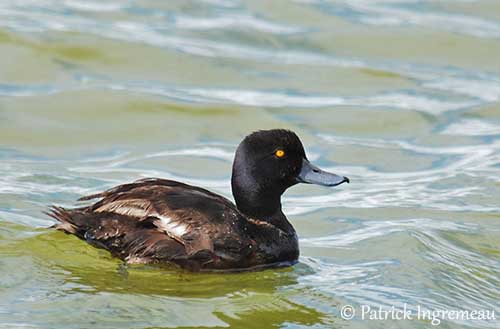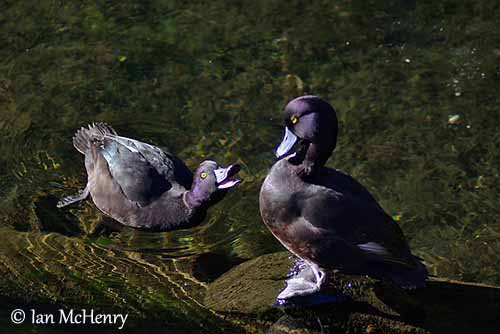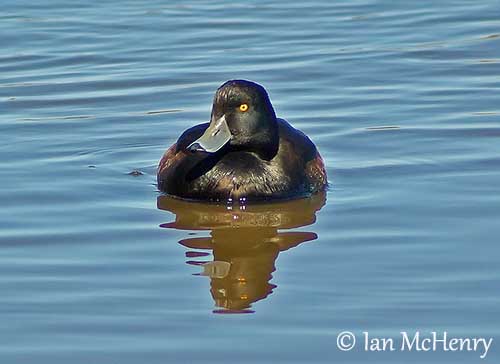
Fr: Fuligule de Nouvelle Zélande
Ang: New Zealand Scaup - Black Teal
Maori: Papango
All: Maoriente
Esp: Porrón Maorí
Ita: Moretta della Nuova Zelanda
Nd: Nieuw-Zeelandse Topper
Sd: Nya Zeelandbergand
Photographers:
Patrick Ingremeau
TAMANDUA
Ian McHenry
My New Zealand Birds
Text by Nicole Bouglouan
Sources:
HANDBOOK OF THE BIRDS OF THE WORLD Vol 3 by Josep del Hoyo-Andrew Elliott-Jordi Sargatal - Lynx Edicions - ISBN : 8487334202
KNOW YOUR NEW ZEALAND BIRDS by Lynnette Moon - New Holland Publishers – ISBN: 1869660897
GUIDE DES CANARDS, DES OIES ET DES CYGNES – de Steve Madge - Delachaux et Niestlé - ISBN: 2603013769
BirdLife International (BirdLife International)
New Zealand bird status between 2008 and 2012
New Zealand birds and birding (Narena Olliver)
Wikipedia, the free encyclopaedia
Te Ara – The Encyclopedia of New Zealand
New Zealand Scaup
Aythya novaeseelandiae
Anseriformes Order – Anatidae Family
INTRODUCTION:
The New Zealand Scaup is the smallest duck of New Zealand. Formerly widespread throughout this region, the species is now restricted to deeper lakes and lagoons of both North and South Islands, due to heavy hunting and changes in its habitat.
This species is endemic to New Zealand. Its Maori name is “Papango”. It is also known as Black Teal.

DESCRIPTION OF THE BIRD:
Biometrics:
Length: 40 cm
Wingspan: 60 cm
Weight: M: 695 g – F: 610 g
The adult has compact body and blackish plumage.
The male has blackish-brown plumage overall with blue-green to purplish iridescence on head and wings. The upperwing shows a broad white band across the secondaries, whereas the underwing is brownish-white.
The underparts are dark too, with light mottling on lower breast and belly.
On the rounded head, the forehead is vertical. The bill is bluish-black with black nail. The eyes are yellow. Legs and webbed feet are black.
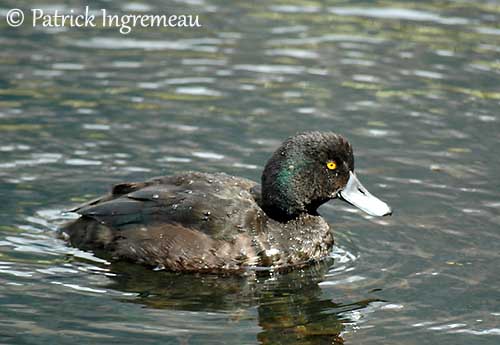
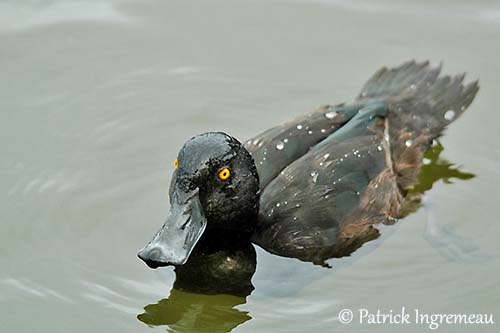
The female is duller brown with paler underparts. The rump is very dark, almost black.
The underparts are mottled brownish-white on lower breast and belly.
The bill is brownish-black. The eyes are brown instead of yellow. Legs and feet are dark brown.
About 50% of females show white feathering around the bill, and mainly during the breeding season.
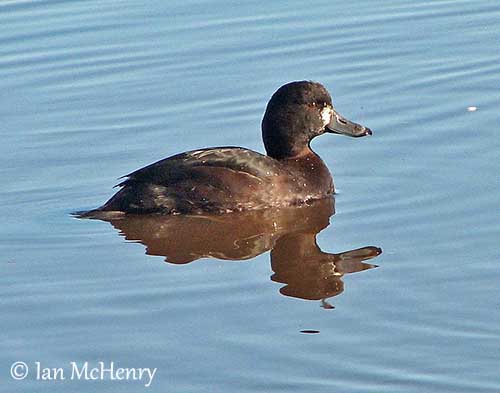
The juvenile resembles female. The young male can be identified at 12 weeks old, when the eyes become yellow.
RANGE:
The New Zealand Scaup occurs in New Zealand, on both North and South Islands. It is found mainly on the subalpine lakes on South Island, West Coast lakes, waterways and hydroelectric lakes.
On North Island, it can be seen on dune lakes in Northland and Manawatu, and on several inland lakes.
HABITAT:
The New Zealand Scaup is common on deep freshwater lakes, and it also frequents the shallow lowland lakes where the numbers are increasing. It can be seen too on slow-flowing rivers and salt water. It avoids shallow wetlands and fast-flowing water.
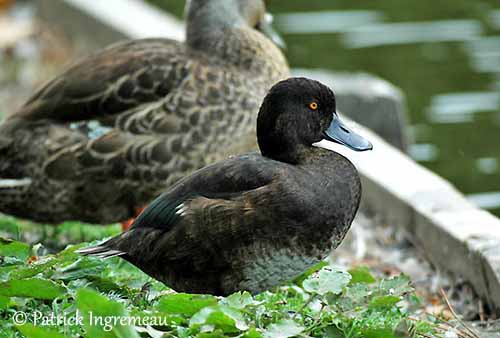
CALLS AND SONGS: SOUNDS BY XENO-CANTO
The New Zealand Scaup male gives high-pitched whistles during the courtship displays “weeee weo-weo weo-weo weo-weoooo”. The female utters low, quiet “wack-wack”.
The calls are usually soft with musical sounds.
BEHAVIOUR IN THE WILD:
The New Zealand Scaup feeds mainly in the early morning and the evening. It feeds on aquatic invertebrates, fish, tadpoles, gastropods and various insects. But it also consumes plant matter such as algae, seeds and shoots of aquatic plants.
It is able to dive until two metres depth while feeding by paddling the feet. It may remain underwater during 15 to 40 seconds. Insects are caught from the surface.
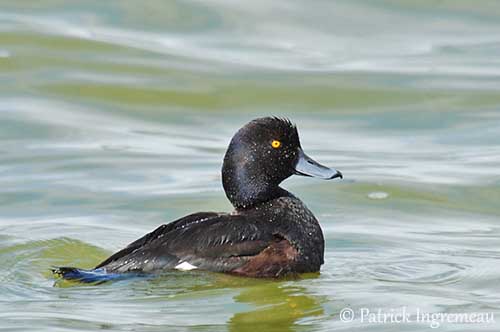
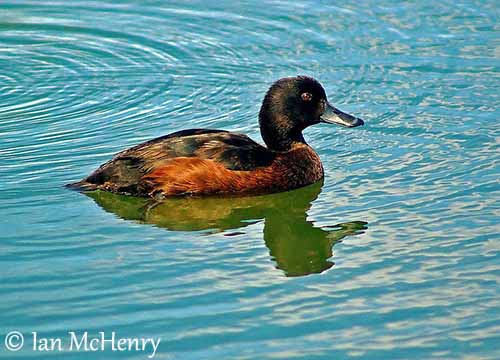
The breeding season involves courtship displays during which the male extends its body flat on the water while uttering soft wheezy whistles “whe-whe” or “tchi-reup”. It also performs rapid upwards head and bill movements.
Aggressive disputes may occur between rivals.
They form flocks during the autumn. By day, they rest on water or on the shores.
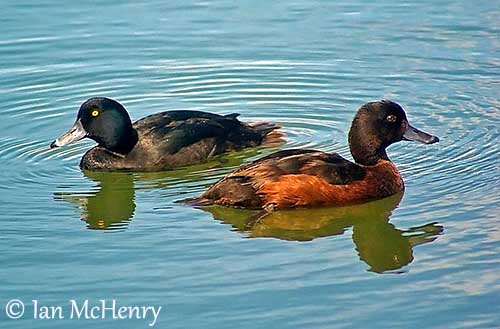
The New Zealand Scaup is sedentary and only performs localised seasonal movements from lake to lake and according to ice conditions during winter.
It is a good flier. It flies low over the water with fast wingbeats and over short distances. It runs actively over the surface before to take off.
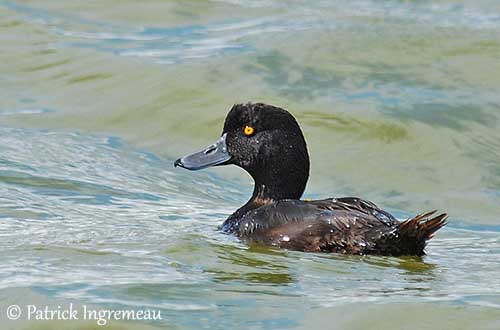
REPRODUCTION OF THIS SPECIES:
The breeding season occurs between October and March. They may form loose colonies near the water, but this species also nests as isolated pairs.
The nest is concealed among the vegetation and placed on the ground. It is bowl-shaped, made with broken reeds and grasses, and well lined with down. The nest is sometimes covered, or may have a tunnel to the nest-chamber.
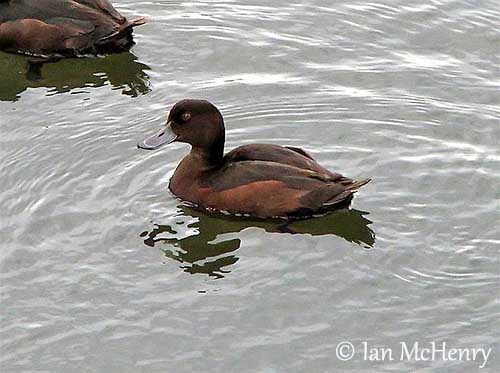
The female lays 5-8 eggs and incubates alone during 27-30 days, while the male remains in close vicinity. At hatching, the chicks have brown down above and paler down below, with whitish spots on face and back. They leave the nest within 24 hours. They are able to dive and to feed themselves. Both parents rear and protect them. They fledge about 7-8 weeks after hatching.
When threatened, the chicks paddle out towards the centre of the lake while the adults distract attention near the shore.
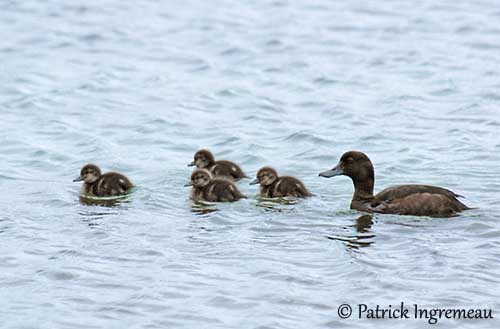
PROTECTION / THREATS / STATUS:
The New Zealand Scaup’s populations suffered declines due to hunting, predation and land clearance. However, conservation and protection measures have allowed expansion in Christchurch.
The population is estimated to number 3,300/6,700 mature individuals, and is suspected to be increasing.
This species is not currently threatened and evaluated as Least Concern.
